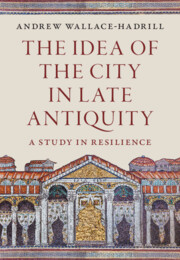Book contents
- The Idea of the City in Late Antiquity
- Praise for The Idea of the City in Late Antiquity
- The Idea of the City in Late Antiquity
- Copyright page
- Dedication
- Contents
- Figures
- Preface
- 1 The End of the Ancient City?
- 2 In Praise of the City
- 3 The City in Question
- 4 The City Revived?
- 5 The City Embattled
- 6 The City and Its Records
- 7 The City of Bishops
- 8 The Grammar of the City
- 9 The Fabric of the City
- 10 Decline and Resilience
- Bibliography
- Index
9 - The Fabric of the City
The Idea Embodied
Published online by Cambridge University Press: 30 January 2025
- The Idea of the City in Late Antiquity
- Praise for The Idea of the City in Late Antiquity
- The Idea of the City in Late Antiquity
- Copyright page
- Dedication
- Contents
- Figures
- Preface
- 1 The End of the Ancient City?
- 2 In Praise of the City
- 3 The City in Question
- 4 The City Revived?
- 5 The City Embattled
- 6 The City and Its Records
- 7 The City of Bishops
- 8 The Grammar of the City
- 9 The Fabric of the City
- 10 Decline and Resilience
- Bibliography
- Index
Summary
While the focus of preceding chapters has been on written sources, this chapter looks at the archaeologicy of cities as evidence for underlying ideas. The old model of the disintegration of a city of straight lines into tangled suqs is hard to reconcile with the evidence. New cities continue to be built through Late Antiquity, with the model set by Constantinople. Far from indicating the grid as the ideal, it is based on Rome itself, a notably non-gridded city. Despite contrasts of terrain, Constantinople competes with old Rome wherever possible. Justinian was responsible for a series of new cities, as Procopius claims, for which we have the advantage of good archaeological studies. If there is a model for these, it is Constantinople itself. Visigothic Reccopolis follows the same pattern. Exceptional among these new cities is the Umayyad foundation of ‘Anjar, outstanding as the most mathematical grid plan since antiquity; the model seems to be in Roman forts. Finally, Charlemagne’s Aachen is examined; though a palace rather than a city, contemporary court poets celebrate it as a New Rome.
- Type
- Chapter
- Information
- The Idea of the City in Late AntiquityA Study in Resilience, pp. 314 - 372Publisher: Cambridge University PressPrint publication year: 2025

